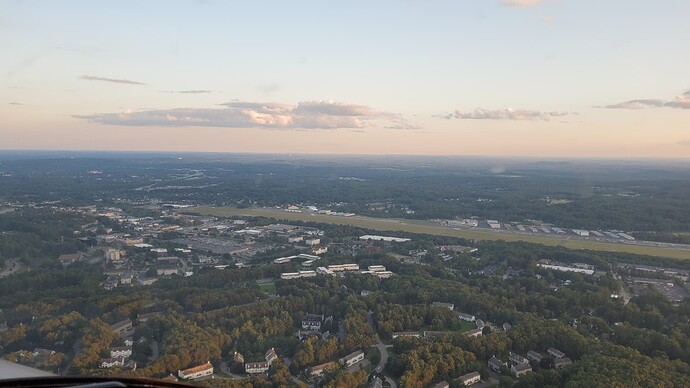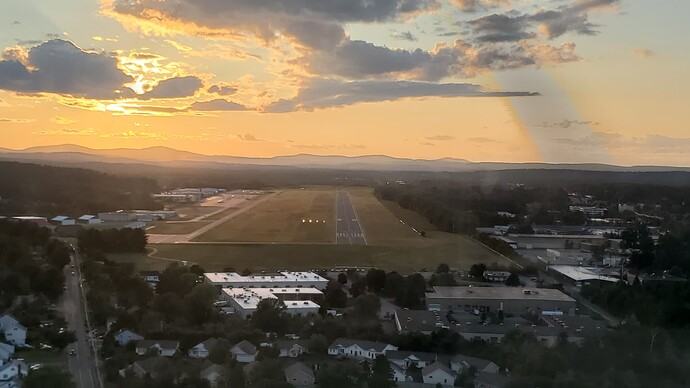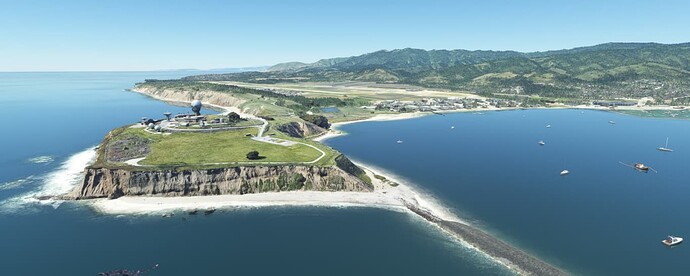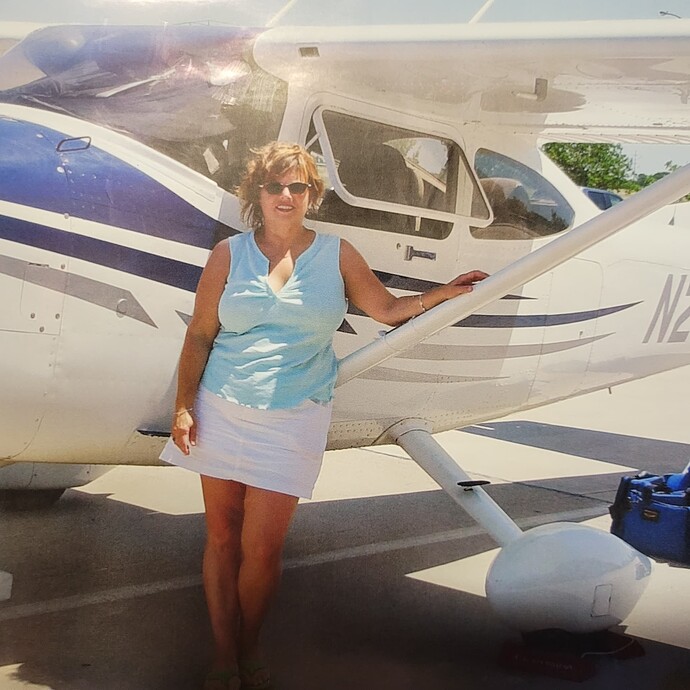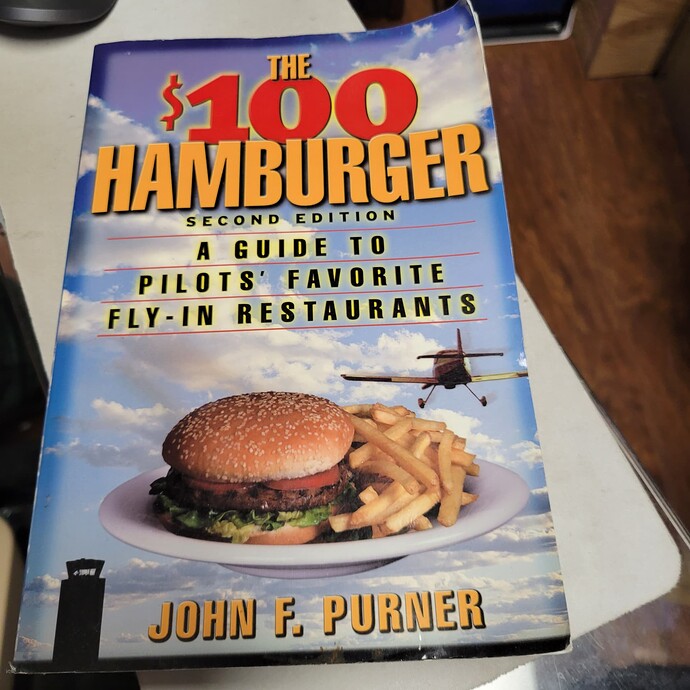Or how long in inches does a 5000 ft airport look like from a mile away? Better yet, can someone post a photo? Thank you.
What a proper approach will look like depends on your system. The best thing to do is practice approaches at an airport with a four light PAPI (Precision Approach Path Indicator) system. Most larger US airports are set up this way. On one or both sides of the landing zone, you’ll find four lights that change from white to red depending on where you are in relation to the 3° glide slope. If you see two white and two red, you’re on the correct approach. Three red is too low, and four red is way too low. Conversely, 3-4 whites mean you’re too high. Once you get the hang of flying the correct angle, you’ll know what the runway should look like when you’re on-target. You’ll then be able to take that knowledge to smaller airports without a PAPI setup and bring your plane in with no problem.
A 5000 ft runway is pretty huge looking from 1 mile away.
It’s actually really visible from 10 miles away.
This is KASH from nearly a mile away
This is from a little less than 1 mi final, maybe 1 mi final
If you’re 1 mile from an airport, you’re nearly on top of it.
These are real pictures, btw, not the sim. I realize it’s hard to tell the difference ![]()
I’m practicing pattern work in KHAF (Half Moon Bay in California). The odd thing is the pattern is non-standard which means it turns right from Runway 30 instead of the standard left turn. To the left is lots of room being the entire Pacific Ocean. To the right is mountains over 1000 feet tall. To make it even more challenging, I’m also using the Longitude, a plane that isn’t conducive to “low and slow”. Since it is a rocket I need to measure distance and height without getting fixated on the instruments much.
Unfortunately, all the pattern tutorials on the net involve GA planes. How would one go about doing pattern work in such a location and plane? Also, generally I have trouble even in GA planes determining when to make turns from 1) upwind to crosswind, 2) crosswind to downwind, and 3) base to final. (downwind to base is easy, it’s 45 degrees).
I’m sorry, I don’t understand your question. Whether the pattern is left or right doesn’t matter procedure is the same. KASH uses both patterns in normal operation, often plane to plane (it’s a towered airport).
Fast movers usually use 1200 or 1500 ft agl as pattern altitude, and fly a larger/longer pattern so things don’t happen too fast, and there’s less likelihood of impact with slower movers.
In a normal GA procedure at or around 100 to 120 or so knots to start, normally when the end of the runway you are going to approach is at about 45 degrees behind you, is about when to turn base. And, of course, you turn final as you approach the extended runway line to where you are…
Usually I gauge to lose about 500 ft/min from the point I pass the end of the runway down to touchdown.
The more you fly any given runway, you’ll find locations at which to do your turns that work best for you.
If you mess up a bit the first time, just go around. No big deal. You can see I was a tad high on my approach in the second picture (though, that may have just had more to do with where I was holding my camera than actually being high). But, I’d rather be a tad high and have to bleed a little altitude, than be low and have to figure out how to add more power…
How do you know when to turn from from the upwind leg (the departure runway)? Are you saying to make the turn when the plane is at 1200-1500 ft AGL?
KHAF is non-towered. So I guess that means every pattern by everyone must be non-standard or to the right?
In the real world, a pilot will graduate from smaller planes to larger, mastering each as they go. Get the basics down in a smaller plane first - any airport will do. This is where you get to the point where you can gauge your glideslope just by looking at the runway - like I talked about earlier. Once you have that skill, then start learning to do the same thing in larger planes while getting the feel of how they react on approach. After that, keep doing like most real pilots do and practice approaches in your plane at your home airport, along with any other destination airport you might travel to on a regular basis. KGSO is apparently listed as some sort of contingency location, so you often see things like C-17’s, P-8’s, and even VC-25’s doing T&G’s here. It’s done to keep up proficiency.
There’s an old joke… A man walks up to a street musician in New York City and asks “Can you tell me how to get to Carnegie Hall?” Without missing a note, the performer just answers “Practice, man, practice!”
"There’s an old joke… A man walks up to a street musician in New York City and asks “Can you tell me how to get to Carnegie Hall?” Without missing a note, the performer just answers “Practice, man, practice!”
That’s actually what I’m trying to do. I’ve practiced on GA planes. But now I am practicing at my home airport using the plane I’d like to use as my go-to plane. Speaking figuratively, most of the tutorials on the net are for playing and practicing the small violin, but I’d rather play the larger cello.
I learned that from my identical twin kids. One plays the violin and the other the cello (they’ve played in Carnegie Hall in real life). I once thought the skills were transferable between the two musical instruments since they look similar. But they’ve convinced me its apples and oranges. So I’m thinking it’s the same thing with flight.
One thing that I should practice more. Especially, when approaching new unfamiliar airport, my approaches are quite bad. As @FlyingsCool5650 mentioned, after some time you identify locations where to turn at familiar airport. At unfamiliar aurport plan your pattern and in map pick some landmarks around that can help you navigate. For example, when I cross this road I should turn downwind. When I see that lake, I should turn base.
Personal Comments
Rod Machado’s Student Pilot lessons in FSX would have greatly helped users in this version. I requal’d in all of them before installing MSFS during the August '20 launch.
Establishing visual cues for offsets and distances is the key - and you’ll just have to practice before it becomes mental memory driven. In general, I’ll enter the pattern mid-field on the up-wind leg. Assuming a left-hand pattern, the key for me is to look out the left wing and see that the runway is bisecting my wing about half-way - that establishes a proper parallel offset. Passing the up-wind end of the runway, I wait until it slides just past my left shoulder FOV, wait three full seconds, then turn to the cross-wind using a 15 degree bank, pulling slightly to stay at altitude. I check the same off-set downwind and adjust as needed. Just past the down-wind end of the runway, I’ll dirty up and set first stage flaps and gear as required. Same situation - let the down-wind end of the runway slide past my left shoulder, wait three seconds, begin the turn to base and start a 300 fpm descent while pulling throttle to about 20 percent. Once I’ve turned to final, adjust heading as necessary (if you kept your turn rate steady and nailed power and descent, it shouldn’t be a very large adjustment). You should be perfectly stabilized for a 3 degree roughly GS, 300-400 fpm rate of descent. Adjust power and add flaps as needed. Keep your sight picture and aim for the TD markers.
Pro-Tip: Using the G1000 NXi, you can cross-check where the Velocity Vector/Flight Path Marker is predicting where you’re going to make contact on the runway if you keep current pitch and power settings. Adjust as needed to put it squarely between the TD markers and Hold. It. There.
Pro-Tip: Set your HDG marker to the runway heading that you’re landing on - even if you keep a heads-forward view (which you really shouldn’t - just like driving a car and changing lanes you need to be able to maintain a manual heading and altitude and still glance left/right/back without grossly changing either), a quick glance at the heading marker will give you a general idea where the runway is oriented around you, and it gives you an additional cue when to stop the bank - i.e., upwind it should be at twelve o’clock, cross-wind and base it should be at your nine o’clock, downwind it should be at six o’clock, etc., assuming an LH pattern.
Typically you begin your turn to your flight path after takeoff at about 700 - 800 ft agl, at a safe altitude. But, if there’s a published “escape route” ( ![]() ) you should follow that.
) you should follow that.
So, at non-towered airports, it depends on the airport which pattern direction to use. Some (most if not all in heavily populated areas) are strictly controlled, typically for population density (safety) and noise abatement reasons, so, it’s best to follow the published procedure, or somebody might write you up if they get angry. In the US, there is no such thing as “standard” pattern like there is in Europe. The pattern direction is whatever direction (and altitude) is published. It could be right on 32 and left on 14. But, it will be published.
But, at an airport like KCON, you can pretty much enter the pattern from whichever direction you’d like (as long as you’re hopefully announcing it). If there’s other planes in the pattern, it’s best to follow them. Although, I’ve definitely been in situations at non-towered airport where I was in a left pattern and somebody else entered the same runway on a right pattern. But they were polite about it and kept proper distance behind me. So, ultimately, how you control your plane is based solely on your judgement and the situation.
@CasualClick and FlyingsCool5650. Thank you both.
How would it be done in a business jet in the KHAF location eg. the Longitude?
Borrowing from that very popular Coca-Cola jingle here’s the “IT’S THE REAL THING!!”
Hi folks.
I fly both my simulator and my 07 Skylane (g1000). Here’s a picture of where all my money goes besides my simulator:
I have a private pilot’s license with an instrument rating… I’m getting close to 2k hours in my log book.
Patterns: (if you are not being told where to enter by the tower and your VFR)
The larger, faster the aircraft, the larger the pattern. If you are flying into a airport that serves both GA and larger private aircraft…FLY the larger pattern. Turns are as you said 45 degrees off the runway …and some airports such as KGPM for example, the turns depend on wind direction and the runway your using.
NEVER fly a VFR straight in approach unless you are 100 % sure no one is in the pattern! Also…pattern flying helps give you time to establish… speed…altitude…landing checklist, etc.
Most entry’s are straight into downwind, or a 45 degree (preferred) angle turning into downwind. The reasoning for this is to give you the maximum view to check for traffic in the pattern… you would be surprised how many pilot’s don’t make position calls within the pattern! If traffic is going to be an issue, call your intentions and do not enter. 99% of airports will tell you pattern altitude on the plates, or call the FBO on the common frequency and ask…otherwise use 1000’ AGL.
Enter AT THE PATTERN ALTITUDE. If you require altitude change …don’t enter! This way you don’t decend on an airplane already in the pattern. Also enter at a speed fast enough to stay clean (no flaps) but slow enough that you can put in the first set of flaps and landing gear.. AKA the white arc. Assuming your flying a left pattern: left downwind…when you get lined up with the numbers at the end of the runway looking left, you pull about 20% of the power, and put in your first set of flaps and lower the gear. (Larger aircraft usually lower the gear entering the pattern). Remember…flaps are to slow down and to get down. Start a 500 fpm drop keeping an eye on your speed, decent rate, and watching for the point where you hit the 45 degree off the runway point. Start a Gentle turn to join left base, put in your next set of flaps, continue 500’ fpm drop. You probably will need to add some power at this point …get established on your landing speed as soon as practical. Adjust your decent if your too low or high…it’s easy once you learn it..by making simple adjustments in power . Watch left for the runway and make a gradual turn onto final.. putting in your 3rd set of flaps (in a cross wind we normally omit the 3rd set of flaps and fly a slightly faster approach) and just like the in the landing challenges…aiming for the 2 painted runway landing point marks. Most runways have aiming lights …red over white ..your alright, white over white, your out of sight, red over red…your dead.
Adjust speed and decent…too high…nose down, less power…etc.
Halfway to the runway you make your decision…land or go around. If your too fast.. you will float.. go around. Not established ( lined up, having trouble getting the speed correct, or any issues) go around! And remember if your dirty (full flaps), don’t retract them all at the same time! Going around watch for aircraft that may be in the pattern upwind!
Get in the habit of never entering the pattern on crosswind. …you could have someone lower, climbing after takeoff, turning onto crosswind.
Turns in the pattern… don’t square your Turns unless the tower tells you to. It’s easy to stall a dirty (flaps out) aircraft doing a tight high angle turn.
Just wonder if its the plane or the woman that is where your money goes?
Based on the info you can find at AirNav: KHAF - Half Moon Bay Airport
Runway 12 has a left pattern, and Runway 30 has a right pattern… It doesn’t say anything about altitude, so, I’d start at about 1100 ft as the pattern altitude. With the Longitude, I’d probably want to have at least a 2 mi final to set up, but, I’m no jet jockey.
There’s also these additional remarks you’ll want to be aware of…
- FLD CONDS-RWY, TWY & APRON GOOD.
- AVOID FLYING DIRECTLY OVER THE PILLAR POINT AIR FORCE STATION.
- ARPT NOISE SENSITIVE AREAS NW THRU NE.
- TWYS, APRONS AND TIEDOWNS: 12,500 LBS MAXIMUM.
- FOR CD CTC NORCAL APCH AT 916-361-0519.
- UNEXPECTED TURBULENT CONDS MAY BE ENCTRD WHILE ON FNA TO RWY 12.
Both… here in the DFW area 100 LL (low lead) is a buck a gallon more than jet A!
OUCH!
And the cost of a nice dinner out has risen as well.
Everyone whos flown irl, started in something small, light and agile. For hours I flew the c152 like it was the coolest airplane on earth. And it really was a great experience. And you get taught reference points and associated actions for normal weather. The landing pattern is, perhaps, the most used teaching. For the first time I got to fly with other pilots and coordinate our movements safely, once I learned the pattern. I only became confident after hours of practice.
Thats where this sim creates some issues for folks, especially if the user has no real world experience. All kinds of planes are provided for no additional money. Heck yes, lets fly some dream plane. And thats great, go for it! But if you wish to fly per the rwgulations, than my advice is to take the 152 on patterns, practicing the advise in this thread. Then, when youre confident move up, but bit by bit. Like fly a single engine complex aircraft round the pattern. Then move on up. But only when you feel comfortable at the previous step.
Yep, ate a few of those back in the days before kids.
